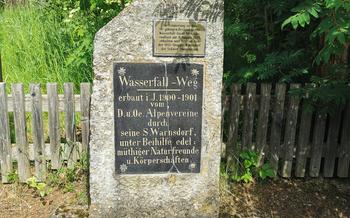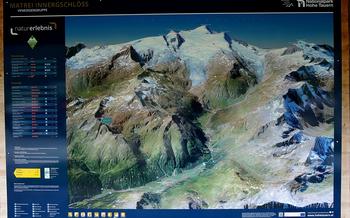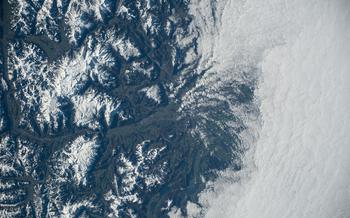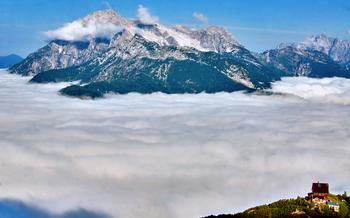
Rauris Gold Panning Site
- A Golden Opportunity in the Alps: Exploring Zell am See's Rauris Gold Panning Site
- Journey Through Time: Unveiling the Secrets of Gold Mining
- Getting There: A Scenic Route to Rauris Gold Panning Site
- Step-by-Step Guide to Gold Panning: Uncovering Hidden Treasures
- What to Expect: A Day at the Rauris Gold Panning Site
- Gold Panning for All Ages: A Family-Friendly Adventure
- Striking Gold: What to Do with Your Precious Findings
- Beyond Gold: Exploring the Rauris Valley's Natural Wonders
- Local Cuisine: Savoring Regional Delights After a Day of Gold Panning
- Accommodation Options: Rest and Relaxation in Zell am See
- Gold Panning Etiquette: Respecting the Site and Fellow Panners
- History of Gold Mining in the Hohe Tauern Region
- Gold Mining Techniques: From Ancient Methods to Modern Machinery
- Insider Tip: Unforgettable Gold Panning Experience at the Rauris Gold Panning Site
A Golden Opportunity in the Alps: Exploring Zell am See's Rauris Gold Panning Site
Nestled amidst the breathtaking scenery of the Hohe Tauern National Park, Zell am See's Rauris Gold Panning Site offers a unique and exciting opportunity to delve into the history of gold mining in the Austrian Alps. With its rich tradition of gold panning dating back centuries, this site provides visitors with an immersive experience, allowing them to uncover the secrets of this precious metal and immerse themselves in the captivating allure of Zell am See's natural beauty.
The Rauris Gold Panning Site is a testament to the region's rich mining heritage. For centuries, miners have sought their fortunes in the rushing waters of the Rauris Valley, panning for gold with the hope of striking it rich. The site preserves this legacy, providing visitors with an authentic glimpse into the techniques and traditions of gold mining. Surrounded by the stunning panorama of the Hohe Tauern National Park, the site offers a breathtaking backdrop for a unique and unforgettable adventure.
Journey Through Time: Unveiling the Secrets of Gold Mining
Gold panning at the Rauris Gold Panning Site is not just about finding gold; it's about stepping back in time and experiencing the rich history of gold mining in the region. Visitors can learn about the traditional techniques used by miners centuries ago, such as panning, sluicing, and dredging. They can also explore the history of the site itself, which has been in operation since the Middle Ages.
The site features a museum that showcases artifacts and tools used by miners, as well as interactive exhibits that explain the process of gold mining. Visitors can also take a guided tour of the site and learn about the lives of the miners who worked there. These tours offer a fascinating glimpse into the challenges and rewards of gold mining, and they help visitors to understand the importance of gold in the history and culture of the region.
Getting There: A Scenic Route to Rauris Gold Panning Site
To reach the Rauris Gold Panning Site from Zell am See, embark on a picturesque journey that unfolds amidst breathtaking alpine scenery. By car, follow the signs towards Rauris and enjoy a leisurely drive along winding roads that snake through lush valleys and past sparkling lakes. The drive takes approximately 45 minutes, offering ample opportunities to stop and capture the stunning vistas that surround you.
For those without a car, public transportation provides a convenient and hassle-free alternative. Hop on the regional bus line 660 from Zell am See bus station and alight at the Rauris Ort station. From there, it's a short walk to the gold panning site. Buses depart regularly throughout the day, ensuring easy access to the site.
If you prefer a more adventurous approach, consider renting a bicycle and embarking on a scenic cycling route to the gold panning site. The journey takes about an hour and offers a unique opportunity to immerse yourself in the natural beauty of the region. Along the way, you'll pass charming villages, rustic farmhouses, and picturesque landscapes that will leave you in awe.
Step-by-Step Guide to Gold Panning: Uncovering Hidden Treasures
Gather Essential Equipment: Before embarking on your gold panning adventure, ensure you have the necessary equipment. This includes a gold pan, shovel, strainer, tweezers, and a bottle of water. You can rent or purchase these items at the Rauris Gold Panning Site.
Choose the Right Location: Selecting a suitable panning spot is crucial for success. Look for areas with visible black sand or gravel deposits, as these often indicate the presence of gold. Avoid panning in fast-flowing water, as it can carry away the gold particles.
Fill Your Pan: Scoop up a shovelful of sand or gravel from the riverbed and place it in your gold pan. Fill the pan about halfway to create a manageable amount of material to work with.
Swirl and Shake: Hold the pan level and submerge it in the water. Begin swirling the pan in a circular motion while gently shaking it from side to side. This action helps loosen and separate the gold particles from the other materials.
Tilt and Rinse: Gradually tilt the pan away from you, allowing the water to flow out while keeping the gold particles trapped inside. Rinse the pan several times, repeating the swirling and tilting motion until most of the sediment is washed away.
Inspect for Gold: Once you have rinsed away the majority of the sediment, carefully examine the remaining material in your pan. Look for small, shiny flakes or specks of gold. Use the tweezers to pick up any visible gold particles and place them in a small container for safekeeping.
Repeat the Process: Continue panning for gold by repeating steps 3-6 until you have exhausted your supply of material or until you find a satisfactory amount of gold. Remember to be patient, as finding gold can take time and practice.
What to Expect: A Day at the Rauris Gold Panning Site
A typical day at the Rauris Gold Panning Site begins with a warm welcome from the friendly staff. They will provide you with all the necessary equipment and safety instructions. Once you're ready, you'll head to the panning area, where you'll be assigned a spot along the riverbank.
The process of gold panning is simple yet captivating. You'll start by filling your pan with water and sediment from the river. Then, using a gentle swirling motion, you'll separate the gold from the other materials. The gold will sink to the bottom of the pan, while the lighter materials will float to the top.
As you continue panning, you'll start to see tiny specks of gold appearing in your pan. These specks can be incredibly small, so it's important to be patient and persistent. With a bit of luck, you may even find a larger nugget.
Throughout the day, you'll have plenty of time to explore the site and learn more about gold panning. There are several information boards that provide insights into the history and techniques of gold panning. You can also watch demonstrations by experienced panners.
The site also offers a range of facilities for visitors. There's a restaurant where you can enjoy a traditional Austrian lunch, as well as restrooms and changing rooms. There's also a gift shop where you can purchase souvenirs and mementos of your gold panning experience.
At the end of the day, you'll have the chance to take your gold findings home with you. The staff will help you to weigh and value your gold, and you can choose to sell it or keep it as a keepsake.
Gold Panning for All Ages: A Family-Friendly Adventure
The Rauris Gold Panning Site is a welcoming destination for individuals, couples, and families with children. The activity is suitable for all ages and abilities, making it a great opportunity for families to bond and create lasting memories together.
The site provides a safe and supervised environment for children to learn about gold panning and experience the thrill of finding their own treasures. Trained instructors are available to guide families through the process and ensure their safety throughout the activity.
For kids, gold panning is a fun and educational way to learn about geology, history, and the natural world. They can also develop their patience, perseverance, and problem-solving skills as they search for gold.
The site also offers engaging activities specifically designed for children, such as panning for gems and minerals, gold-themed crafts, and interactive displays about the history of gold mining in the region. These activities help kids stay entertained and engaged while learning about the fascinating world of gold panning.
Striking Gold: What to Do with Your Precious Findings
After a successful day of gold panning, you'll likely be wondering what to do with your newfound treasures. The first step is to determine the value of your gold. You can do this by taking it to a local jeweler or gold dealer, who will assess its purity and weight. The value of your gold will depend on the current market price of gold, as well as the purity and weight of your findings.
Once you know the value of your gold, you have several options. You can sell it to a jeweler or gold dealer for cash, or you can keep it as a keepsake. If you decide to keep your gold, you can have it made into custom jewelry, such as a ring, necklace, or bracelet. This is a great way to commemorate your gold panning adventure and create a unique and personal piece of jewelry.
Beyond Gold: Exploring the Rauris Valley's Natural Wonders
Gold panning is undoubtedly the star attraction of the Rauris Valley, but the region offers a wealth of natural wonders beyond its golden treasures. The surrounding mountains, Hohe Tauern National Park, and crystal-clear lakes provide a stunning backdrop for outdoor enthusiasts and nature lovers.
The Hohe Tauern National Park, Austria's largest national park, encompasses much of the Rauris Valley. With its towering peaks, lush forests, and pristine lakes, the park offers a haven for wildlife and a paradise for hikers, bikers, and climbers. Explore the scenic hiking trails that wind through the park, taking you past cascading waterfalls, alpine meadows, and breathtaking viewpoints.
The Rauris Valley is also home to several crystal-clear lakes, inviting visitors to swim, fish, and boat amidst stunning scenery. Take a refreshing dip in the cool waters of Lake Rauris, cast your line for trout in the crystal-clear streams, or embark on a leisurely boat trip across the tranquil lakes, soaking in the serene beauty of the surrounding mountains.
Keep an eye out for the diverse wildlife that calls the Rauris Valley home. The Hohe Tauern National Park is home to a variety of animals, including marmots, chamois, deer, and even the elusive golden eagle. With a bit of luck, you might catch a glimpse of these magnificent creatures in their natural habitat.
Local Cuisine: Savoring Regional Delights After a Day of Gold Panning
After a rewarding day of gold panning and exploring the natural wonders of the Hohe Tauern National Park, it's time to indulge in the culinary delights of the Rauris Valley. The region boasts a rich culinary heritage, influenced by both Austrian and Italian traditions. Here's a guide to the must-try dishes and where to find them:
- Traditional Austrian Dishes:
- Kaiserschmarrn: A fluffy shredded pancake served with powdered sugar and fruit compote.
- Wiener Schnitzel: Thinly pounded and breaded cutlet of veal or pork, typically served with potato salad.
-
Gulasch: A hearty beef stew flavored with paprika and caraway seeds, often served with dumplings or bread.
-
Local Specialties:
- Rauriser Schlipfkrapfen: Pasta pockets filled with spinach and cheese, served with melted butter and chives.
- Pinzgauer Kasnocken: A casserole made with potato dumplings, cheese, and onions.
-
Hohe Tauern Lamm: Tender lamb raised in the region's mountain pastures, often grilled or roasted.
-
Recommended Restaurants:
- Gasthof Tauernblick: Offers traditional Austrian dishes with stunning views of the Hohe Tauern mountains.
- Hotel Restaurant Goldried: Serves a variety of regional specialties in a cozy and inviting atmosphere.
-
Alpenhotel Tauernhof: A family-friendly restaurant with a menu featuring local delicacies and international favorites.
-
Tips for Packing a Picnic Lunch:
- Include fresh local produce, such as bread, cheese, and fruit, from the Rauris Valley markets.
- Pack a refreshing beverage, such as Austrian beer or apple juice, to quench your thirst after a day of panning.
- Find a scenic spot along the Rauris River or in the Hohe Tauern National Park to enjoy your picnic with breathtaking views.
Accommodation Options: Rest and Relaxation in Zell am See
After a thrilling day of gold panning, rejuvenate with a comfortable stay in Zell am See. The town offers a diverse range of accommodation options to suit every preference and budget. Whether you seek the charm of a traditional guesthouse, the convenience of a modern hotel, or the privacy of an apartment, Zell am See has it all.
When selecting your accommodation, consider factors such as proximity to the gold panning site, amenities offered, and your desired level of comfort. For a truly immersive experience, opt for a hotel or guesthouse in the heart of Zell am See, allowing you to explore the town's historic streets, charming shops, and lively cafes at your leisure.
To find the best deals and discounts, book your accommodation in advance, especially during peak tourist season. Numerous online platforms and travel agents offer competitive rates and last-minute bargains. Consider staying in neighboring towns or villages for more affordable options while still enjoying easy access to Zell am See and the Rauris Gold Panning Site.
Gold Panning Etiquette: Respecting the Site and Fellow Panners
Gold panning is a fun and rewarding activity, but it's crucial to remember that we share the site with others and the environment. Here are some guidelines to ensure a positive experience for all:
-
Tread Lightly: Respect the natural beauty of the site by avoiding littering and disturbing the flora and fauna.
-
Leave No Trace: Clean up your panning area before leaving, and dispose of waste responsibly in designated bins.
-
Share the Wealth: If you find a particularly rich spot, don't monopolize it. Allow others to share in the joy of discovery.
-
Safety First: Follow all safety regulations and guidelines, and be aware of your surroundings.
-
Be Considerate: Avoid making excessive noise or obstructing the panning areas of others.
-
Respect the Miners: Remember that the site is a place of work for the miners who maintain it. Be respectful of their efforts.
-
Educate Yourself: Learn about the history and techniques of gold panning before your visit. This will enhance your appreciation of the experience.
By following these simple guidelines, we can all contribute to a safe, enjoyable, and sustainable gold panning experience at the Rauris Gold Panning Site.
History of Gold Mining in the Hohe Tauern Region
Gold mining has a long and rich history in the Hohe Tauern region, dating back to the Middle Ages. The region's mountains are home to some of the oldest and most productive gold mines in Austria. Gold was first discovered in the Hohe Tauern in the 12th century, and mining operations quickly began. The mines were initially worked by hand, but over time, more sophisticated methods were introduced, including water-powered mills and stamp mills.
At its peak, the Hohe Tauern region was one of the most important gold-mining regions in Europe. The mines produced large quantities of gold, which was used to mint coins, make jewelry, and other valuable objects. The gold mining industry also played a significant role in the development of the region, providing employment and wealth for many people.
Today, the Hohe Tauern region is still home to a number of gold mines, although most of them are no longer in operation. However, the Rauris Gold Panning Site offers visitors a chance to experience the thrill of gold panning for themselves. The site is located in a beautiful alpine setting and offers stunning views of the surrounding mountains. Visitors can learn about the history of gold mining in the region and try their hand at panning for gold.
Gold Mining Techniques: From Ancient Methods to Modern Machinery
Gold mining techniques have evolved significantly over time, reflecting advancements in technology and our understanding of the geology and chemistry of gold. In the early days, miners relied on simple tools and methods to extract gold from riverbeds and alluvial deposits. Panning, a technique that involves swirling a pan of sediment in water to separate gold from other materials, has been used for centuries and is still practiced today at the Rauris Gold Panning Site.
As mining operations expanded and the demand for gold increased, miners began to develop more sophisticated techniques. In the Middle Ages, miners used waterwheels and pumps to drain mines and access deeper gold deposits. The invention of explosives in the 19th century revolutionized mining, allowing miners to break through hard rock and reach previously inaccessible gold veins.
In the 20th century, the development of heavy machinery and new technologies, such as cyanide leaching and flotation, further transformed the gold mining industry. These methods allowed miners to process large quantities of ore more efficiently and extract gold from ores that were previously considered uneconomical to mine.
Today, a combination of traditional and modern techniques is used in gold mining operations around the world. While panning remains a popular method for recreational gold mining, large-scale mining operations employ a range of technologies, including open-pit mining, underground mining, and heap leaching, to extract gold from various types of deposits.
Insider Tip: Unforgettable Gold Panning Experience at the Rauris Gold Panning Site
Seasoned gold panners at the Rauris Gold Panning Site often whisper about a secret spot, a hidden gem where the chances of finding gold nuggets are said to be higher. While the exact location remains a closely guarded secret, there are a few tips to help you discover this treasure trove.
First, venture off the beaten path and explore the lesser-known streams and creeks within the site. These secluded spots often receive less foot traffic, increasing your odds of finding undisturbed gold deposits.
Second, pay attention to the water flow. Look for areas with slower-moving water, as gold tends to settle in these calmer spots. Conversely, avoid areas with strong currents, as the gold may have been washed away.
Finally, don't be afraid to experiment with different panning techniques. While the traditional method is effective, trying alternative approaches may yield surprising results. Remember, gold panning is as much an art as it is a science, so let your curiosity and intuition guide you.
Sharing your gold panning adventures with friends and family is a wonderful way to create lasting memories. Capture your discoveries on camera, share your stories of triumph and disappointment, and inspire others to embark on their own gold panning journeys.









